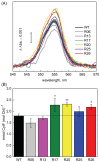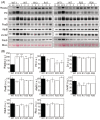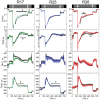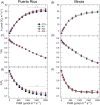Rieske FeS overexpression in tobacco provides increased abundance and activity of cytochrome b6 f
- PMID: 36259085
- PMCID: PMC9828649
- DOI: 10.1111/ppl.13803
Rieske FeS overexpression in tobacco provides increased abundance and activity of cytochrome b6 f
Abstract
Photosynthesis is fundamental for plant growth and yield. The cytochrome b6 f complex catalyses a rate-limiting step in thylakoid electron transport and therefore represents an important point of regulation of photosynthesis. Here we show that overexpression of a single core subunit of cytochrome b6 f, the Rieske FeS protein, led to up to a 40% increase in the abundance of the complex in Nicotiana tabacum (tobacco) and was accompanied by an enhanced in vitro cytochrome f activity, indicating a full functionality of the complex. Analysis of transgenic plants overexpressing Rieske FeS by the light-induced fluorescence transients technique revealed a more oxidised primary quinone acceptor of photosystem II (QA ) and plastoquinone pool and faster electron transport from the plastoquinone pool to photosystem I upon changes in irradiance, compared to control plants. A faster establishment of qE , the energy-dependent component of nonphotochemical quenching, in transgenic plants suggests a more rapid buildup of the transmembrane proton gradient, also supporting the increased in vivo cytochrome b6 f activity. However, there was no consistent increase in steady-state rates of electron transport or CO2 assimilation in plants overexpressing Rieske FeS grown in either laboratory conditions or field trials, suggesting that the in vivo activity of the complex was only transiently increased upon changes in irradiance. Our results show that overexpression of Rieske FeS in tobacco enhances the abundance of functional cytochrome b6 f and may have the potential to increase plant productivity if combined with other traits.
© 2022 The Authors. Physiologia Plantarum published by John Wiley & Sons Ltd on behalf of Scandinavian Plant Physiology Society.
Figures








Similar articles
-
Faster induction of photosynthesis increases biomass and grain yield in glasshouse-grown transgenic Sorghum bicolor overexpressing Rieske FeS.Plant Biotechnol J. 2023 Jun;21(6):1206-1216. doi: 10.1111/pbi.14030. Epub 2023 Mar 2. Plant Biotechnol J. 2023. PMID: 36789455 Free PMC article.
-
Enhanced leaf photosynthesis as a target to increase grain yield: insights from transgenic rice lines with variable Rieske FeS protein content in the cytochrome b6 /f complex.Plant Cell Environ. 2016 Jan;39(1):80-7. doi: 10.1111/pce.12594. Epub 2015 Nov 3. Plant Cell Environ. 2016. PMID: 26138548
-
Overexpression of the Rieske FeS protein of the Cytochrome b6f complex increases C4 photosynthesis in Setaria viridis.Commun Biol. 2019 Aug 16;2:314. doi: 10.1038/s42003-019-0561-9. eCollection 2019. Commun Biol. 2019. PMID: 31453378 Free PMC article.
-
The cytochrome b6f complex: plastoquinol oxidation and regulation of electron transport in chloroplasts.Photosynth Res. 2024 Mar;159(2-3):203-227. doi: 10.1007/s11120-023-01034-w. Epub 2023 Jun 27. Photosynth Res. 2024. PMID: 37369875 Review.
-
The cytochrome b6f complex at the crossroad of photosynthetic electron transport pathways.Plant Physiol Biochem. 2014 Aug;81:163-83. doi: 10.1016/j.plaphy.2013.12.011. Epub 2013 Dec 27. Plant Physiol Biochem. 2014. PMID: 24485217 Review.
Cited by
-
Deciphering the genetic landscape of enhanced poly-3-hydroxybutyrate production in Synechocystis sp. B12.Biotechnol Biofuels Bioprod. 2024 Jul 16;17(1):101. doi: 10.1186/s13068-024-02548-8. Biotechnol Biofuels Bioprod. 2024. PMID: 39014484 Free PMC article.
-
The atypical Dof transcriptional factor OsDes1 contributes to stay-green, grain yield, and disease resistance in rice.Sci Adv. 2024 Aug 23;10(34):eadp0345. doi: 10.1126/sciadv.adp0345. Epub 2024 Aug 23. Sci Adv. 2024. PMID: 39178266 Free PMC article.
-
Comparative and Phylogenetic Analysis of Complete Chloroplast Genomes of Five Mangifera Species.Genes (Basel). 2025 May 30;16(6):666. doi: 10.3390/genes16060666. Genes (Basel). 2025. PMID: 40565558 Free PMC article.
-
Characterization of PetM cytochrome b6f subunit 7 domain-containing protein in tomato.Hortic Res. 2023 Nov 8;10(12):uhad224. doi: 10.1093/hr/uhad224. eCollection 2023 Dec. Hortic Res. 2023. PMID: 38094587 Free PMC article.
-
Faster induction of photosynthesis increases biomass and grain yield in glasshouse-grown transgenic Sorghum bicolor overexpressing Rieske FeS.Plant Biotechnol J. 2023 Jun;21(6):1206-1216. doi: 10.1111/pbi.14030. Epub 2023 Mar 2. Plant Biotechnol J. 2023. PMID: 36789455 Free PMC article.
References
-
- Anderson, J.M. , Dean Price, G. , Soon Chow, W. , Hope, A.B. & Badger, M.R. (1997) Reduced levels of cytochrome bf complex in transgenic tobacco leads to marked photochemical reduction of the plastoquinone pool, without significant change in acclimation to irradiance. Photosynthesis Research, 53, 215–227.
-
- Bendall, D.S. , Davenport, H.E. & Hill, R. (1971) Cytochrome components in chloroplasts of the higher plants. In: Methods in enzymology, Vol. 23. New York: Academic Press, pp. 327–344.
MeSH terms
Substances
Grants and funding
LinkOut - more resources
Full Text Sources
Miscellaneous

